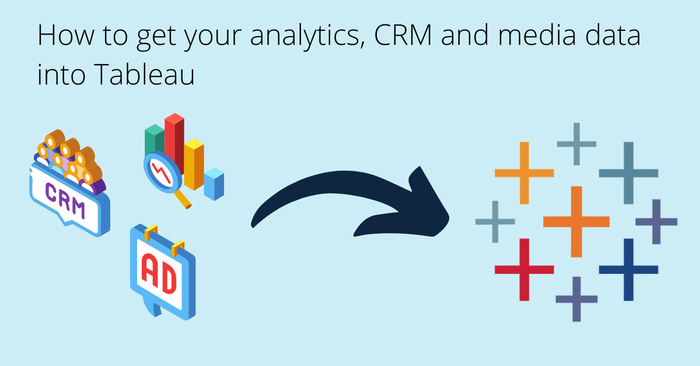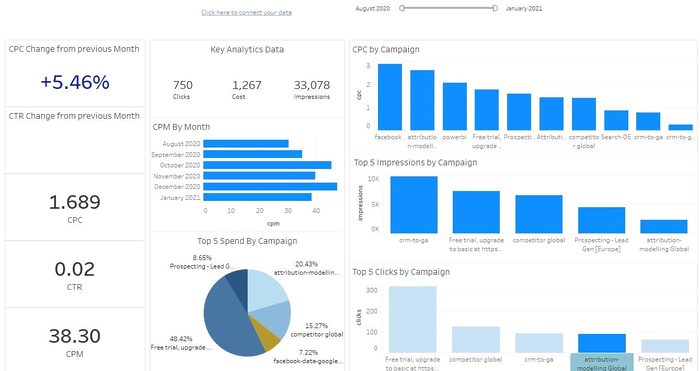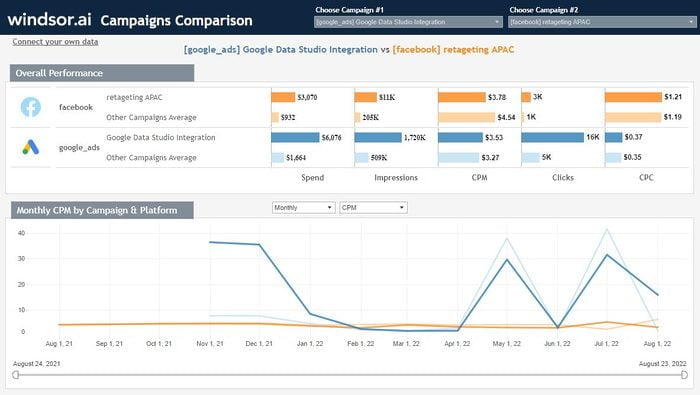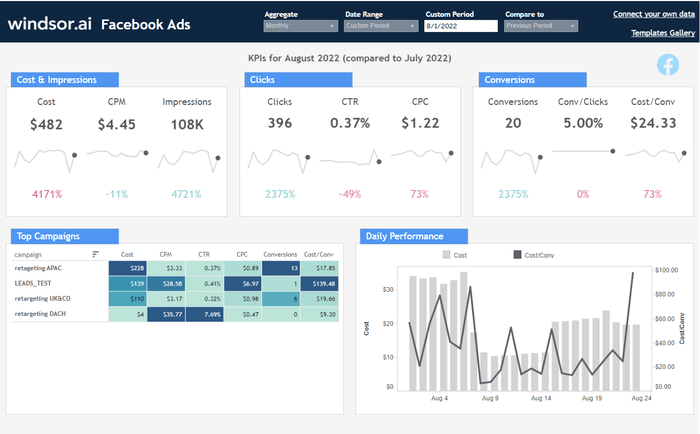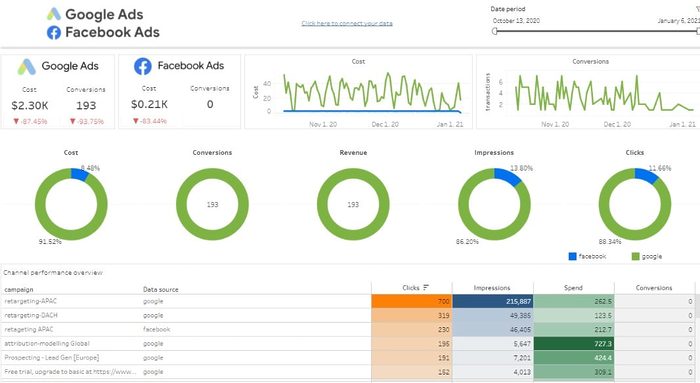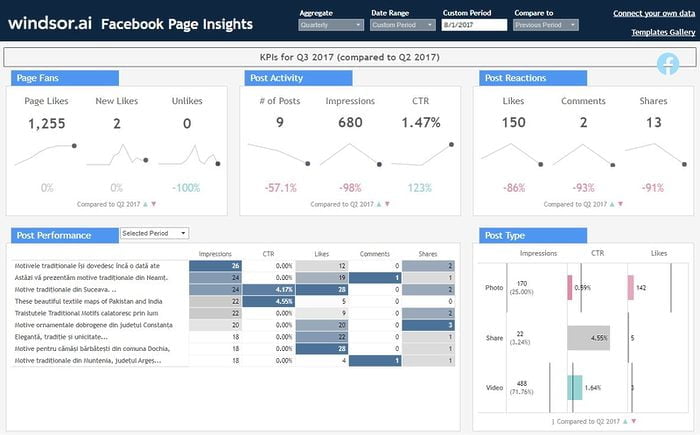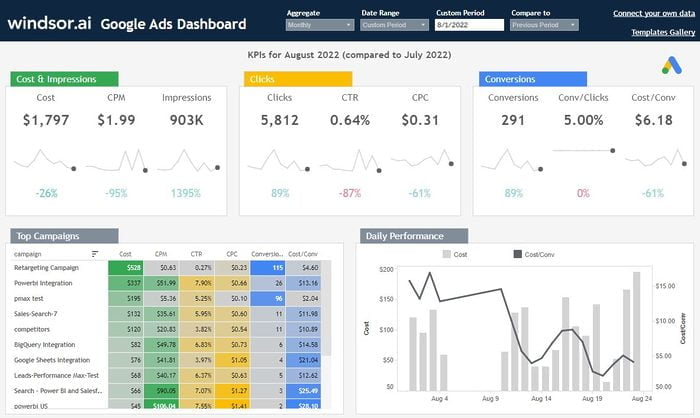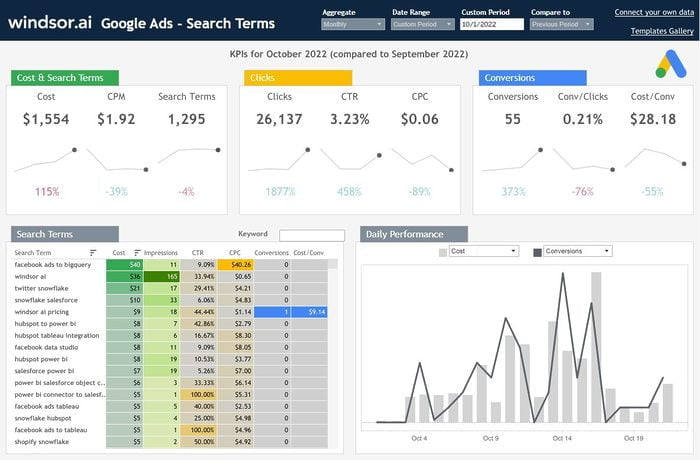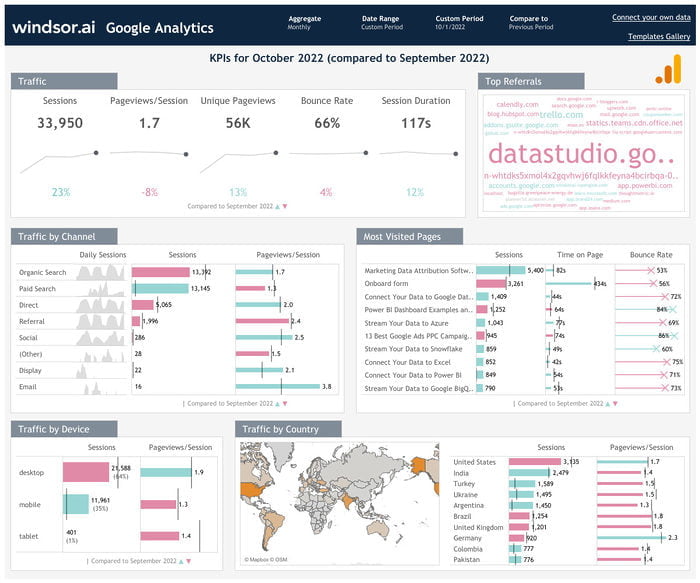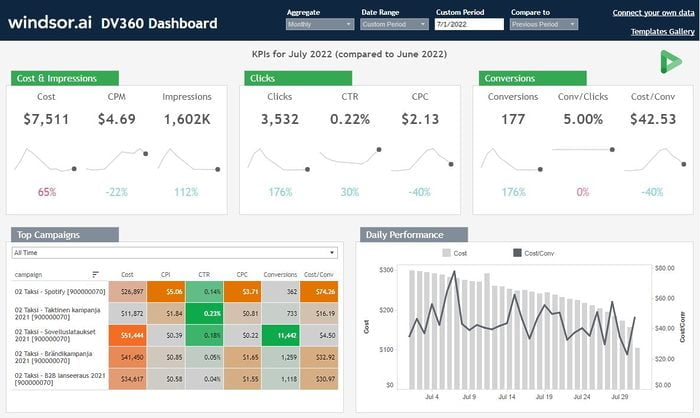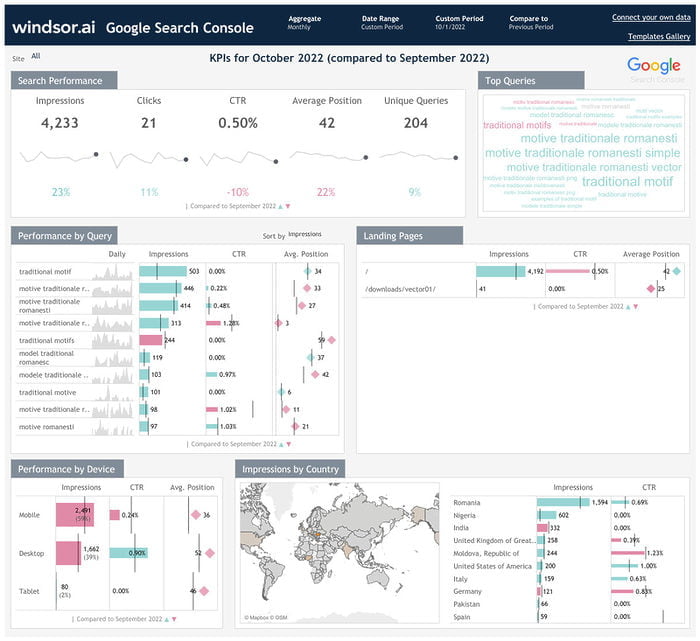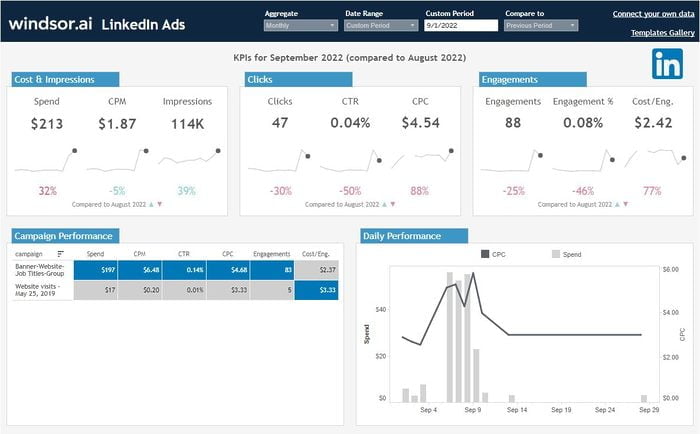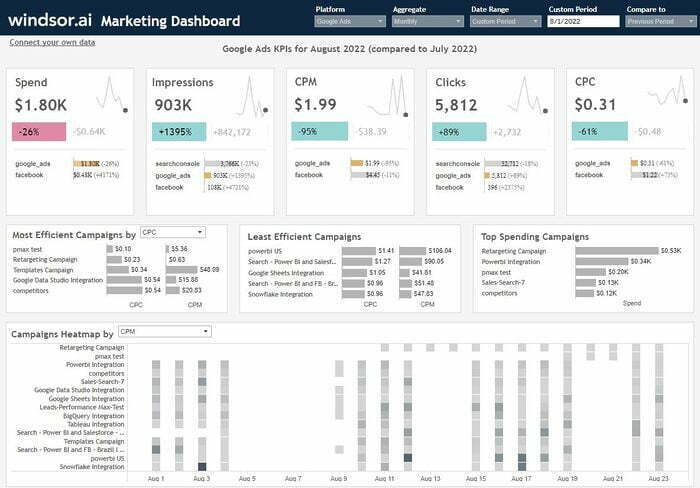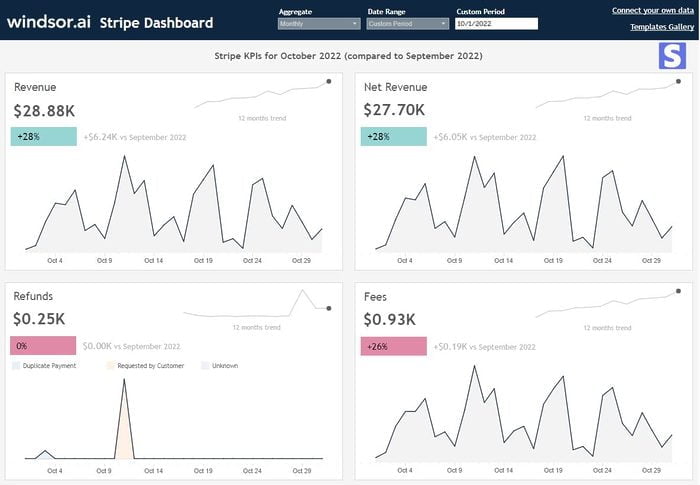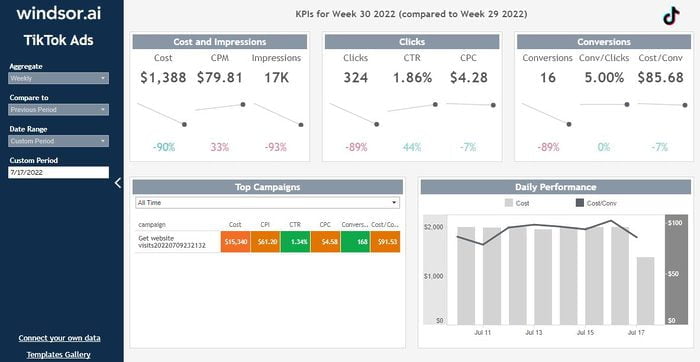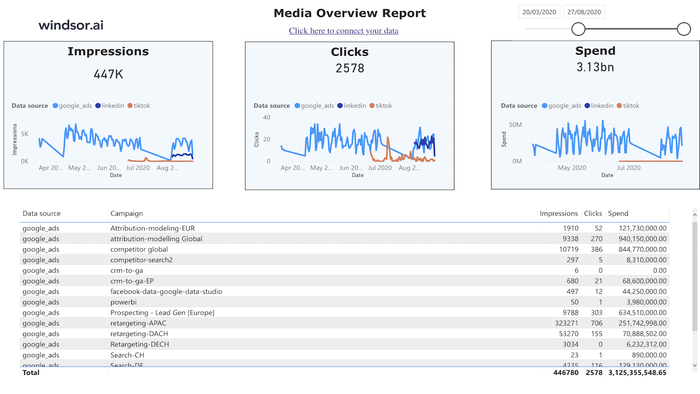Free Tableau Dashboard Templates
Windsor.ai guarantees an effortless Tableau marketing reporting process for all our users. Creating dashboards from scratch takes a lot of effort. Allow Tableau dashboard templates to do the heavy lifting and help you save time. Free Tableau dashboard templates feature easy-to-follow instructions for connecting your own data. Find a suitable template from Tableau’s library and use it to save time and effort and increase productivity.
What is Tableau Marketing Dashboard?
Tableau marketing dashboard is a tool that visualizes key marketing data to help you gain important information on ad performance, social media presence, email marketing efficiency, lead generation, etc. The findings are essential and guide you in making data-driven decisions that improve the overall performance across various marketing channels.
Marketing reports created through Tableau dashboards are easily shareable; everyone within the organization can access them instantly. No advanced coding knowledge is required. By bringing all employees on board, better decisions that align with marketing goals are made. You can also align workflows as needed and find answers to pressing questions, helping you gain a competitive edge.
Top 10 Free Tableau Dashboard Templates
Here are Tableau dashboard examples that you can access through the Tableau gallery:
- Social Media Dashboard: This dashboard presents the performance metrics from social media accounts. It highlights data related to engagement rates, user demographics, and follower growth to help marketers develop more effective campaigns.
- SEO Analytics Dashboard: Showcases organic traffic, website performance, keyword rankings, and backlink profiles to determine the efficiency of your SEO strategy. You can later formulate innovative measures to enhance search visibility and increase traffic.
- PPC Dashboard: Essential for businesses running online ad campaigns to help them gauge performance insights. By monitoring indicators such as conversion rates, ROI, ad spend, impressions, and clicks, the PPC dashboard enables you to focus more on best-performing channels and find solutions for underperforming ones.
- Sales Dashboard: With this realtime dashboard, sales executives can follow relevant indicators (sales trends, sales distribution, product performance, leads) to gauge revenue growth, losses, etc. The insights may inspire the formulation of creative sales approaches that drive growth.
- Content Marketing Dashboard: Helps you get insights into content performance by visualizing conversion rates, traffic, leads generated, and engagement across different channels. Consequently, you can create better content that drives results.
- Email Marketing Dashboard: Brings enormous value to your business by displaying subscriber growth, open rates, click-through rates, etc., using charts, graphs, or numbers. You can discover what works and what doesn’t to optimize email content and targeting for improved conversions.
- Web Analytics Dashboard: This express dashboard helps visualize website performance. It highlights user activity, conversion rates, traffic sources, etc., to enable users to improve engagement and online presence.
- Lead generation dashboard: Assesses metrics associated with lead acquisition by tracking data like lead sources, lead volume, and lead quality. This helps explore lead generation performance and improve the current strategies to increase revenue and conversions.
- E-Commerce Marketing Dashboard: Provides an overview of e-commerce operations through metrics like completed orders, total sales, number of sellers, and review score. Using this information, you could forecast demand and meet customer needs on time.
- KPI TrackingDashboard : Visualizes key indicators like customer satisfaction scores, revenue, and profit margins. With these insights, stakeholders can determine progress in the achievement of goals and spot areas requiring improvement to inspire smart decision-making.
Benefits of Using Tableau Dashboards
Tableau dashboards offer numerous benefits, including:
Visual insights
Tableau templates provide various tools like tables, charts, and maps to help you visualize data. This makes it easy for stakeholders to gain insights into various metrics and make informed decisions.
Data integration
Tableau easily integrates with multiple sources, enabling you to combine and assess data in a single dashboard.
Real-time updates
You can configure dashboards to be updated with the latest information from the linked data sources, ensuring you make relevant decisions.
Collaboration
Sharing Tableau report templates, dashboards, and insights is easy. This is also essential as it enables teams to collaborate in decision-making, leading to better outcomes.
Scalable
Tableau can comfortably expand as your data needs grow. As a result, it’s able to handle large and complex datasets effectively, as well as generate responsive dashboards fast.
Reporting
With the assistance of Tableau report builder, you are able to generate, design, and publish paginated reports customized to your organization’s requirements.
FAQs
What is Tableau?
Tableau is a powerful tool for analyzing and visualizing data. It allows individual professionals and businesses to generate shareable reports and dashboards using data from different sources.
What is Tableau used for?
Tableau enables users to perform numerous functions, including data visualization, analysis, reporting, integration, and storytelling.
How to share the Tableau report
You have several options when it comes to sharing Tableau reports. One is to publish the report online or to a server and later share it by granting access to recipients. Another way is to generate a link to the report, embed it in web pages or emails, and share it with teammates. Alternatively, you can publish it publicly and share the URL provided online for everyone to view.
How much is Tableau?
With Tableau, you have different pricing packages depending on your desired deployment method and edition. Payable licenses are categorized into Tableau Creator, Tableau Explorer, and Tableau Viewer, and their monthly costs are $75, $42, and $15, respectively. A free version is available for those who want to use the free Tableau templates before committing to any plan.
Power BI vs Tableau
Power BI is a creation of Microsoft and easily integrates with multiple sources and helps users visualize their data through charts, graphs, tables, etc., for faster decision-making. Tableau is good at data exploration and storytelling, thanks to its drag-and-drop functionality and expansive visualization tools.
How to use Tableau
Using Tableau is easy; you can kick-start the process by connecting it to a data source. The next step is to drag and drop fields onto the canvas to create visualizations. Then, find exciting data points and focus on specific results. Filters and colors can help you with this. Plot the data on a map, build a dashboard to display your insights, create a story, and share your findings.
How to publish the Tableau dashboard
Locate the toolbar and select the sharing option. Key in the names of the recipients and send. Users will receive a notification about the shared dashboard.
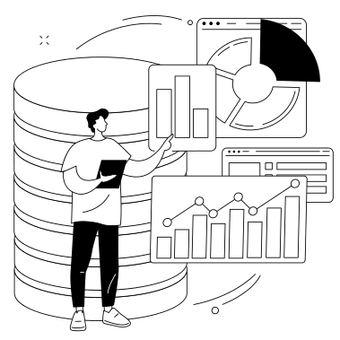
Try Windsor.ai today
Access all your data from your favorite sources in one place.
Get started for free with a 30 - day trial.
